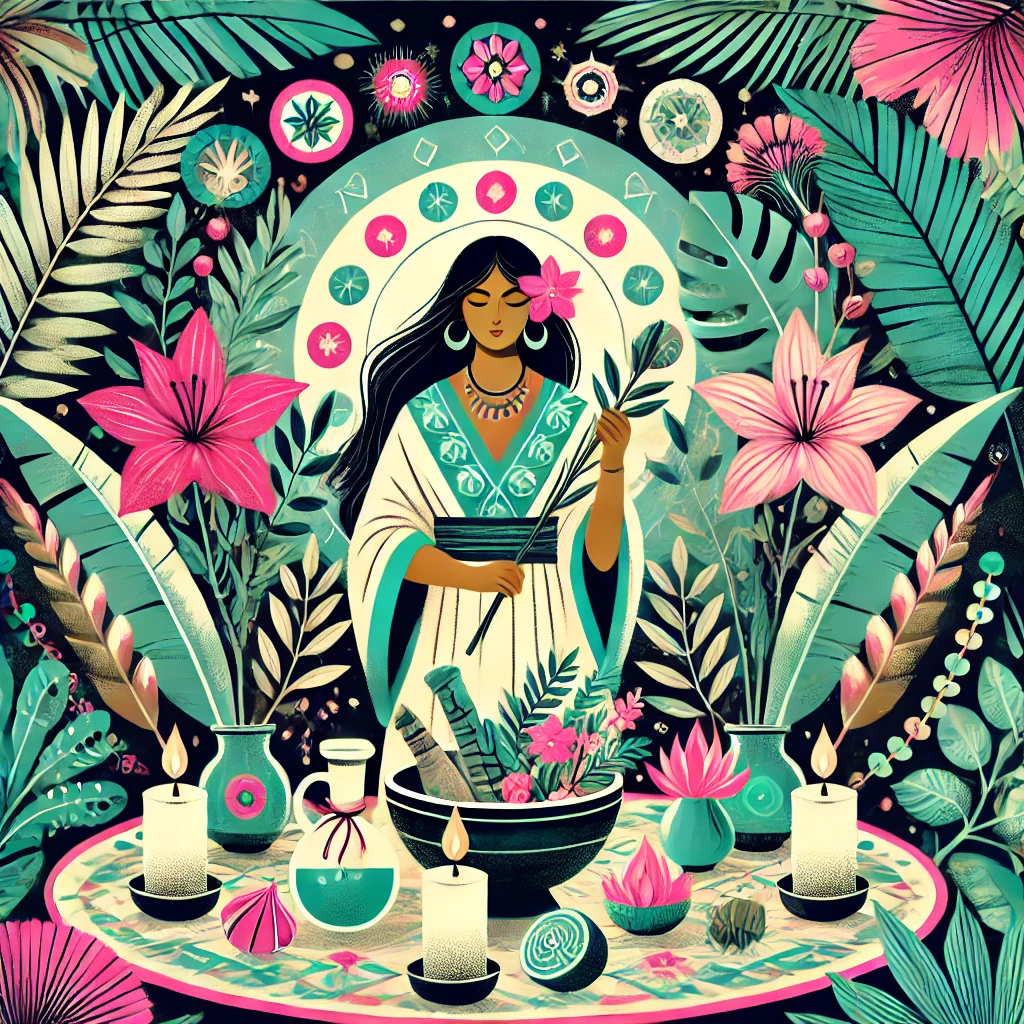What is a Curandera
Role: A Curandera is a holistic healer who addresses physical, emotional, and spiritual ailments. They are often seen as community caregivers.
Focus: Healing through nature, spiritual energy, and community care.
________________
Curandero/a comes from the root curar in Spanish which literally translates to cure. A Curandera is one that cures.
Curanderas are often viewed as a vital part of their communities, serving not only as healers and guides. They offer holistic approaches to healing including Physical remedies for illnesses or injuries; Emotional healing for stress, grief, or interpersonal conflict; and Spiritual cleansing to remove negative energies or the mal de ojo (evil eye).
Curanderas are as diverse as the cultures of Latin America, as are their tools. Some make use of simple herbs, others add Catholic elements, and others emphasize their native spirituality. Still, others use hallucinogenic material, such as mushrooms.
Curanderas often specialize in specific types of healing such as:
Yerbera: Specializes in the use of medicinal herbs.
Sobadora: Focuses on physical manipulation, like massage, to treat injuries or ailments.
Espiritista: Works primarily with spiritual energy, connecting with spirits or ancestors for guidance.
Parteras: Midwives that help with child birth
Hueseros: Bone and muscle therapists who emphasize physical ailments.
In addition, some have sub-specialities. Tabaqueros work with tobacco for healing. Ayahuasqueros work with ayahuasqua, and so forth. In addition, many curanderos may have specialize in diverse types of healing.
History of Curanderas
The tradition of curanderismo has deep roots in Latin America, originating from the practices of indigenous peoples, who had an understanding of native plants.
Over centuries, different Curandera pathways gave rise, with the influence of the various groups that called Latin America home. This syncretism resulted in unique healing traditions that honor the interconnectedness of body, spirit, and nature.Each community and even families developed their own practices, informed by their specific wisdom and background.
In Colonial Latin America, curanderas were often conflated with brujas and hechizeras, who cast spells, leading to their persecution.
Common Practices of Hechizeras
Herbal Remedies
Curanderas are deeply knowledgeable about the healing properties of plants and use herbal remedies to treat physical and emotional ailments. They prepare teas, tinctures, poultices, and baths using a variety of medicinal plants. For instance, chamomile (manzanilla) might be used for calming the nerves, while aloe vera is applied to wounds or burns. The curandera’s knowledge often comes from a combination of Indigenous wisdom and personal experience, passed down through generations. These remedies address everything from digestive issues to headaches and stress.
Spiritual Diagnosis
Curanderas often begin their work with a spiritual diagnosis to uncover the root cause of a problem, which may be physical, emotional, or spiritual in nature. By interpreting signs, such as how an egg behaves when cracked into water or how a candle burns, the curandera identifies hidden influences affecting the client. This diagnosis serves as the foundation for the healing process. Energy healing is a practice that focuses on restoring balance to the body’s energy fields, which are believed to influence physical and emotional health. A curandera may place their hands on or near the client’s body, channeling positive energy to areas of imbalance. This practice may involves invoking guides, to assist in the process. Objects might also be used to help align the client’s energy and dispel negativity, ensuring a holistic approach to healing.
Spiritual Cleansing (Limpias) and Sweat Lodge
Spiritual cleansing, or limpias, is one of the most well-known practices of a curandera. It involves the removal of negative energy, illness, or bad luck from a person’s body and spirit. This is often done using tools like eggs, herbs, or candles. The sweat lodge is a traditional purification ceremony guided by curanderas in some regions. It involves sitting in a small, enclosed space filled with herbal steam, created by pouring water over heated stones. The temazcal serves as a ritual for cleansing the body, mind, and spirit, often accompanied by prayers, chanting, or meditation. Participants leave feeling renewed and reconnected to themselves and the natural world.
Offering Guidance
Curanderas often act as counselors, providing spiritual and practical advice for personal, familial, or community issues. Their guidance is rooted in traditional wisdom and often informed by spiritual practices, such as dream interpretation or meditation. Clients seek curanderas not only for physical healing but also for emotional and relational support, trusting their deep understanding of human struggles and cultural values.
Preservation of Curanderas Tradition
The role of a curandera is more than just healing—it is a link to the past and a vessel for preserving cultural identity. As curanderismo continues to adapt to modern life, it remains a testament to the resilience and wisdom of indigenous and folk traditions.
Curanderas remain an integral part of many Latin communities. They offer a more holistic and culturally resonant form of care, particularly for those who value traditional practices. Today, curanderismo is experiencing a resurgence, as people seek alternative and ancestral methods of healing that prioritize community, spirituality, and connection to the earth.
Curanderas remind us of the power of nature, spirituality, and ancestral knowledge in restoring balance and harmony.



